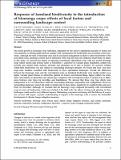| dc.contributor.author | Bourke, David | |
| dc.contributor.author | Stanley, Dara | |
| dc.contributor.author | O'Rourke, Erin | |
| dc.contributor.author | Thompson, Rosalyn | |
| dc.contributor.author | Carnus, Tim | |
| dc.contributor.author | Dauber, Jens | |
| dc.contributor.author | Emmerson, Mark | |
| dc.contributor.author | Whelan, Pádraig | |
| dc.contributor.author | Hecq, Florence | |
| dc.contributor.author | Flynn, Evelyn | |
| dc.contributor.author | Dolan, Lisa | |
| dc.contributor.author | Stout, Jane | |
| dc.date.accessioned | 2017-05-09T12:55:25Z | |
| dc.date.available | 2017-05-09T12:55:25Z | |
| dc.date.issued | 2013-07-19 | |
| dc.identifier.citation | Bourke, D., Stanley, D., O'Rourke, E., Thompson, R., Carnus, T., Dauber, J., Emmerson, M., Whelan, P., Hecq, F., Flynn, E., Dolan, L. and Stout, J. (2014), Response of farmland biodiversity to the introduction of bioenergy crops: effects of local factors and surrounding landscape context. GCB Bioenergy, 6: 275–289. doi:10.1111/gcbb.12089 | en_IE |
| dc.identifier.issn | 1757-1707 | |
| dc.identifier.uri | http://hdl.handle.net/10379/6502 | |
| dc.description.abstract | The recent growth in bioenergy crop cultivation, stimulated by the need to implement measures to reduce net CO2 emissions, is driving major land-use changes with consequences for biodiversity and ecosystem service provision. Although the type of bioenergy crop and its associated management is likely to affect biodiversity at the local (field) scale, landscape context and its interaction with crop type may also influence biodiversity on farms. In this study, we assessed the impact of replacing conventional agricultural crops with two model bioenergy crops (either oilseed rape Brassica napus or Miscanthus à  giganteus) on vascular plant, bumblebee, solitary bee, hoverfly and carabid beetle richness, diversity and abundance in 50 sites in Ireland. We assessed whether within-field biodiversity was also related to surrounding landscape structure. We found that local- and landscape-scale variables correlated with biodiversity in these agricultural landscapes. Overall, the differences between the bioenergy crops and the conventional crops on farmland biodiversity were mostly positive (e.g. higher vascular plant richness in Miscanthus planted on former conventional tillage, higher solitary bee abundance and richness in Miscanthus and oilseed rape compared with conventional crops) or neutral (e.g. no differences between crop types for hoverflies and bumblebees). We showed that these crop type effects were independent of (i.e. no interactions with) the surrounding landscape composition and configuration. However, surrounding landscape context did relate to biodiversity in these farms, negatively for carabid beetles and positively for hoverflies. Although we conclude that the bioenergy crops compared favourably with conventional crops in terms of biodiversity of the taxa studied at the field scale, the effects of large-scale planting in these landscapes could result in very different impacts. Maintaining ecosystem functioning and the delivery of ecosystem services will require a greater understanding of impacts at the landscape scale to ensure the sustainable development of climate change mitigation measures. | en_IE |
| dc.description.sponsorship | This research was funded by the SIMBIOSYS Project (http://www.tcd.ie/research/simbiosys/, 2007-B-CD-1-S1) as part of the Science, Technology, Research and Innovation for the Environment (STRIVE) Programme, financed by the Irish Government under the National Development Plan 2007–2013, administered on behalf of the Department of the Environment, Heritage and Local Government by the Irish Environmental Protection Agency. | en_IE |
| dc.format | application/pdf | en_IE |
| dc.language.iso | en | en_IE |
| dc.publisher | Wiley Open Access | en_IE |
| dc.relation.ispartof | GCB Bioenergy | en |
| dc.rights | Attribution-NonCommercial-NoDerivs 3.0 Ireland | |
| dc.rights.uri | https://creativecommons.org/licenses/by-nc-nd/3.0/ie/ | |
| dc.subject | Farmland biodiversity | en_IE |
| dc.subject | Bioenergy crops | en_IE |
| dc.subject | Biodiversity | en_IE |
| dc.subject | Bioenergy crops | en_IE |
| dc.subject | Brassica napus | en_IE |
| dc.subject | Climate change mitigation measures | en_IE |
| dc.subject | Edge density | en_IE |
| dc.subject | Grasslands | en_IE |
| dc.subject | Landscape composition | en_IE |
| dc.subject | Landscape configuration | en_IE |
| dc.subject | Miscanthus 9 giganteus | en_IE |
| dc.subject | Model averaging | en_IE |
| dc.subject | Seminatural habitats | en_IE |
| dc.title | Response of farmland biodiversity to the introduction of bioenergy crops: effects of local factors and surrounding landscape context | en_IE |
| dc.type | Article | en_IE |
| dc.date.updated | 2017-04-27T14:57:05Z | |
| dc.identifier.doi | 10.1111/gcbb.12089 | |
| dc.local.publishedsource | http://dx.doi.org/10.1111/gcbb.12089 | en_IE |
| dc.description.peer-reviewed | peer-reviewed | |
| dc.contributor.funder | |~| | |
| dc.internal.rssid | 11213380 | |
| dc.local.contact | Dara Stanley, Room 225, Ryan Institute, Botany And Plant Science, , School Of Natural Sciences, National University Of Ireland Galway. 3422 Email: dara.stanley@nuigalway.ie | |
| dc.local.copyrightchecked | No | |
| dc.local.version | PUBLISHED | |
| nui.item.downloads | 496 | |


